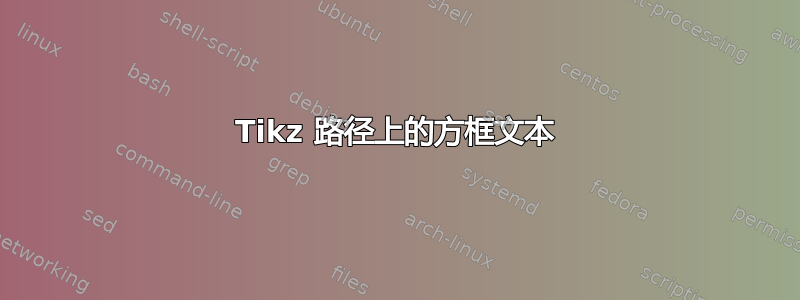
需要将第一张图片上的文字框起来(实线,不是虚线),但线条要用虚线……这是 MWE:
\documentclass[10.5pt,b5paper]{memoir}
\usepackage[english]{babel}
\usepackage[utf8]{inputenc}
\usepackage[T1]{fontenc}
\usepackage{graphicx}% http://ctan.org/pkg/graphicx
\usepackage{xcolor} %
\definecolor{gr}{RGB}{200,250,200}
\usepackage{tikz}
\usetikzlibrary{shapes,arrows,automata}
\usetikzlibrary{arrows,decorations.pathmorphing,decorations.pathreplacing,
decorations.shapes,shadows,backgrounds,decorations.markings}
\begin{document}
\begin{figure}[!h]
\begin{center}
\begin{tikzpicture}
[auto,
block/.style ={rectangle, draw=gr!10!black, thick, fill=gr,
text width=7.1em,align=center, minimum height=4em, decorate, decoration={random steps,segment length=3pt,amplitude=1pt}},
line/.style ={draw, thick, densely dashed, -latex',shorten >=2pt},
cloud/.style ={rectangle, rounded corners, fill=blue!20, minimum height=7em, text width=7.1em, align=center}]
\matrix [column sep=14mm,row sep=11mm]
%draw,text width=100pt, text centered, line width=1pt, fill=gr, minimum height=2cm, minimum width=2.5cm, decorate, decoration={random steps,segment length=3pt,amplitude=1.5pt}
{
&\node [block] (p1) {Programm 1}; &\\
\node [cloud] (keyboard) {Keyboard}; &
\node [block] (p2) {Programm 2}; &
\node [cloud] (display) {Terminal}; &\\
&\node [block] (p3) {Programm 3}; &\\
};
\begin{scope}[every path/.style=line]
\path (keyboard) |- node {\small{\hspace{2cm} test1 }} (p1);
\path (p1) -- node[sloped,above] {\small{test1}} (p2);
\path (p1) edge [bend left=35] node[sloped,above,red] {\small{test 2}} (display);
\path (p2) -- node[sloped,above,red] {\small{test1}} (display);
\path (p3) -- node[sloped,above,red] {\small{test1}} (display);
\path (p2) -- node[sloped,above] {\small{test1}} (p3);
\path (p3) edge [bend left=-35] node[sloped,above] {\small{test 2}} (display);
\end{scope}
\end{tikzpicture}
\vspace{-\baselineskip}
\end{center}
\caption{I want texts on lines to be in box with solid line like below}
\end{figure}
\begin{tikzpicture}
[auto,
block/.style ={rectangle, draw=gr!10!black, thick, fill=gr,
text width=7.1em,align=center, minimum height=4em, decorate, decoration={random steps,segment length=3pt,amplitude=1pt}},
line/.style ={draw, thick, densely dashed, -latex',shorten >=2pt},
cloud/.style ={rectangle, rounded corners, fill=blue!20, minimum height=7em, text width=7.1em, align=center}]
\matrix [column sep=34mm,row sep=11mm]
{
\node [block] (p) {Programm}; &
\node [cloud] (display) {Terminal}; &\\
};
\begin{scope}[every path/.style=line]
\path decorate[decoration={markings, mark connection node=my node, mark=at position .5 with
{\node [draw,red,transform shape] (my node) {How to make this box,but not line, solid?};} }] {(p) -- (display)};
\end{scope}
\end{tikzpicture}
\end{document}
答案1
这是一个可能的解决方案。
基本上,重要的部分是:
node[draw,solid,above=3pt,near end]在直角箭头的末端附近插入文本节点。
node[draw,solid,above=3pt]以实心样式在节点周围稍微向上绘制框架,这样框架就不会覆盖箭头。
\documentclass{standalone}
\usepackage{xcolor} %
\definecolor{gr}{RGB}{200,250,200}
\usepackage{tikz}
\usetikzlibrary{shapes,arrows,automata}
\usetikzlibrary{arrows,decorations.pathmorphing,decorations.pathreplacing,
decorations.shapes,shadows,backgrounds,decorations.markings}
\begin{document}
\begin{tikzpicture}[%
auto,
block/.style={%
rectangle,
draw=gr!10!black,
thick,
fill=gr,
text width=7.1em,
align=center,
minimum height=4em,
decorate,
decoration={random steps,segment length=3pt,amplitude=1pt}
},
line/.style={%
draw,
thick,
densely dashed,
-latex',
shorten >=2pt
},
cloud/.style={%
rectangle,
rounded corners,
fill=blue!20,
minimum height=7em,
text width=7.1em,
align=center
}
]
\matrix[column sep=14mm,row sep=11mm]
{
& \node [block] (p1) {Programm 1}; & \\
\node [cloud] (keyboard) {Keyboard}; &
\node [block] (p2) {Programm 2}; &
\node [cloud] (display) {Terminal}; & \\
& \node [block] (p3) {Programm 3}; & \\
};
\begin{scope}[every path/.style=line]
\path (keyboard) |- node[draw,solid,above=3pt,near end]
{\small{test 1}} (p1);
\path (p1) -- node[sloped,above=3pt,draw,solid]
{\small{test 1}} (p2);
\path (p1) edge [bend left=35] node[sloped,above=3pt,red,draw,solid]
{\small{test 2}} (display);
\path (p2) -- node[sloped,above=3pt,red,draw,solid]
{\small{test 1}} (display);
\path (p3) -- node[sloped,above=3pt,red,draw,solid]
{\small{test 1}} (display);
\path (p2) -- node[sloped,above=3pt,draw,solid]
{\small{test 1}} (p3);
\path (p3) edge [bend left=-35] node[sloped,below=3pt,draw,solid]
{\small{test 2}} (display);
\end{scope}
\end{tikzpicture}
\end{document}



